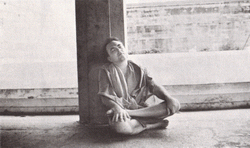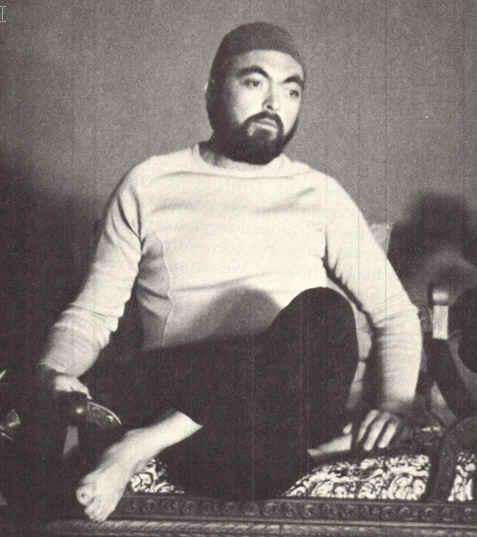Originally published in the Vision Mound Magazine

True Worship Is the Sacrifice of the Whole Body
from a talk given by Bubba Free John at Vision Mound Sanctuary
September 10, 1977
BUBBA: The principal lesson of our trip to India is that the subjectivity conventionally associated with spirituality-mind, inwardness, passivity, the “left side” is an illusion. When you get into that mood, you drop out of the sphere of relations. Wherever there is identification with subjectivity, there is the absence of love, the failure of love. What appears in India, in ashrams and on the streets, is exactly that the failure of love, the failure of relationship. It is the inward turning, subjectively oriented tendency in which life is considered to be nothing, people are considered to be nothing, and relations are to be struggled with and avoided. The tendency is just the opposite in the Western world, which is violent, but it is also outwardly oriented, relationally oriented, oriented toward the experiences of the gross life rather than the subtle life.
Yet there is just as much to criticize about the Western world in its rightsidedness. We spent last summer here engaging and considering all of the possibilities of the gross, worldly life and came to the point of abandoning that right-handed principle in itself. This trip represents the same consideration applied to the left-handed tendency, the anti-relational tendency, the inward, subjective tendency. The result of this essential consideration is the realization that spiritual life is the sacrificial orientation of the whole body through love. It is not inwardness in itself, or the left side and upper coil of the being. Nor is it outwardness in itself, or the right side and lower coil of the body-being. It is unobstructed feeling-attention through all functions, in all relations, under all conditions.
India is the epitome of left-sided glamor and the absence of energy. One thing that is impressive about being in India, that feels good about being in India, is the absence of violence. There is no violent quality in the people. They do not feel dangerous as people generally feel in the West. People in the West are aggravated, and you feel the tendency toward violence and its possibility immediately. It is right there all the time. But the quality of violence is naturally absent in Indians, because the dimension of relationship, intentional life-force, love, sexuality-the whole force of relations-is suppressed. So, naturally, violence and the outward expressions of energy in general are suppressed, not expressed, in the conventions of Indian culture.
The tendency that is “India” is a psychological and cultural drive. The culture of India is part of the psychology of Western people who get wearied or complicated by the play of outward life that Westerners live naturally, and so, by reaction, like to withdraw, to go within, to go to the left. That withdrawal is one of the classically conventional solutions to life, but it is not spirituality. It is not spiritual life.
What people usually consider to be spiritual is the game of the subjective dream world. In that sense India is the Disneyland of spirituality. Going to India is like going into your own imagination-all the illusions of subjectivity are enshrined there. All those temples and ashrams are shrines to the left hand view, the interiorizing, subjective, subtly or mentally oriented way of life.
People must understand what the practice of this Teaching is it is not the left-handed path, nor is it the right-handed exploitation of ordinary life. It is not the withdrawal of energy, nor is it the exploitation of things in themselves. It is to live the principle of love, but not the principle of love as it is conventionally understood-you know, love one another and that is Truth. It is feeling-attention brought into the field of all functions and all relations under all conditions. It is to be present as Radiance. It is to be committed in love to relations, to live them fully, to realize, then, the Lawful discipline inherent in relations of love.
In India you hear all about renunciation and detachment. From the common Indian point of view renunciation means withdrawal, separation from functions and relations. But that separation is not true renunciation or true detachment. True renunciation is to love to Infinity, to love absolutely, to love to the point that you are releasing what you love. Such loving is not the same as exploiting some object that you are holding on to for its own sake, but neither is it the left-handed view of separation. The people we saw in India, sitting around working on themselves, basically having no energy in their relations with one another, passive in their orientation, and inward-they might as well be in a rest home somewhere. People who have renounced relationship are not happy people at all. There is no sign of happiness in them. What does unhappiness have to do with spiritual life? Nothing, obviously!
So if the problem is attachment to the subjective illusion of inwardness, separation from relations, and therefore the failure of love, the failure of service, then you can see why so much of my work involves purifying people by making lessons in life. Such theatre has been necessary because of the weakness and inconstancy and lack of commitment of human beings in general, who are tending in two conventional directions. On the one hand, they are always wanting to go out and blow their minds – drink and smoke and sex and live the wild, outward, Western life. But on the other hand, the opposite tendency is also present in everyone in the cycles and phasing of their attention and feeling. That tendency is to think that spiritual life is the game of turning within and working on yourself, manipulating yourself, doing it yourself, acquiring certain experiences through either self-manipulation or vicarious contact. Both the outward and the inward tendencies represent the failure of love, the failure of the real process, or sacrifice of the whole body. Thus, people approaching the Church are constantly phasing in their relationship to this Teaching and to their own Spiritual Master because of their left- and rightsided tendencies, inward and outward.

This trip was a dramatic symbol for the left-handed tendency, that specific justification for the failure of love, service, real spiritual life, and commitment to this Way and this Company. But its purpose was also to make a pilgrimage of sacrifice, to yield the left-sided drama entirely. They expected me to make a grand tour, meet all the types, go to all the places, and then come back with grand stories. But I simply went to the last point of contact that was of significance to me, to nowhere else, and I just threw all the rest of it away there. I went to the Poondiswami1 and gave it all to him, because he represents the cultic figure in its most classically absurd form. The Poondiswami is really what it is all about for the Indian who makes an idol of subjectivity out of the Divine. The subjective idol is not Truth, not God.

WILLIAM: You said that the Poondiswami is like an icon in one of the temples.

BUBBA: He and all the rest of them. People are willing to do puju,2 to perform little rituals, little formal games inside or outside themselves, and they want to call that spiritual life. The true puja is the sacrifice of the whole body. It is the life of love. It is the spiritual process in its radical form, as I have described it. It is a whole lifetime of constantly mature participation in the spiritual process. Such participation requires constancy, commitment, intelligence, clarity, love, feeling-attention, energy. Subjective commitment is the withdrawing of energy, the withholding of feeling -attention the failure to love. It is just as much a failure as all the outward, wild, gross activities that people tend to. But generally people do not consider sin to be the failure to love. They think that sin is the indulgence of the senses. They think their subjective orientation is in the God-ward direction. But that is absolutely untrue, you see. Subjectivity is just the other side of the body.
You are free of these two tendencies, self-indulgence and subjectivity, when you have inspected them to the point that you can maintain your commitment to real life with some stability. Then you can live the true discipline, the whole body discipline, the true puja or sacrifice of the whole body, which is what has been demanded by teachers in the past and which I also demand. Such sacrifice is the end to all of the rituals of the left side and the right side, the external sacrifices, the sacrifices of things that you are not, whether goats or the body. The sacrifice must be what you are you are the sacrifice, not Jesus, not a goat, and not the body that you separate from. The whole body is the sacrifice, gross, subtle, and causal, physical, mental, egoic, not through a process of withdrawal, but through a living process of existing as the whole body yielded to Infinity.
Self-indulgence and subjectivity are great psychological tendencies. The qualities of right and left are strategies that appear in the dramatization that is everyone’s life. They are always there, confusing people about the whole matter of spiritual life. If you look for wisdom to either the right or the left side, you will not find it! You will find only confusion; you will find opposition to something that you are already considering to be true. The left and right sides together are an argument; they are in phase with one another, polarized to one another. Therefore, they are constantly moving you through cycles in your orientation. The play between them is just stuff, you see, the content of experience. In response, you must simply presume the Lawful conditions of existence, considering this Teaching, living in this Company, and living the essential disciplines as they are communicated. True life has nothing to do with dwelling on tendencies, left or right. Those will appear in their own way, but they are neither to be dramatized nor to become a matter of concern.
1. The Poondiswami is a true kundalini yogi who was found by townspeople some years ago on the bank of a river outside the village of Poondi. He is a classic representative of the traditional practice of kundalini yoga, which seeks to merge the life-force, or Creative Power of the universes, that lies dormant in man, coiled at the base of the spine, into subtle light via the manipulation of internal energy- processes. The Poondrswami’s practice is to give Shaktipat initiation through ceremonial ritual. He is literally approached as a Divine statue or object, and ceremoniously worshipped in the classic South Indian manner-ritually bathed with butter, sandalwood paste, honey, milk, and other foods, and then ritually washed, in the same manner as a piece of statuary considered to be a representation of the Divine.
2. Puja is a traditional Hindu ceremony which involves objective worship of deities through symbolic ritual.
William telling of Adi Da’s Meeting with Sri Poondi Swami in 1977